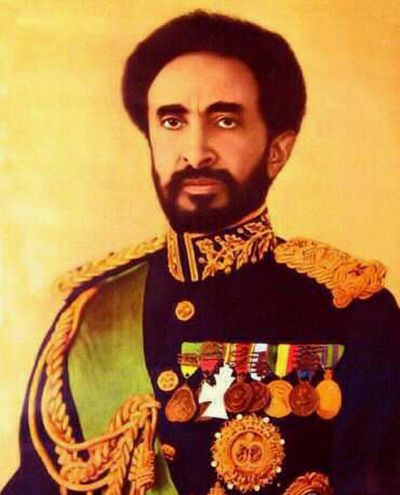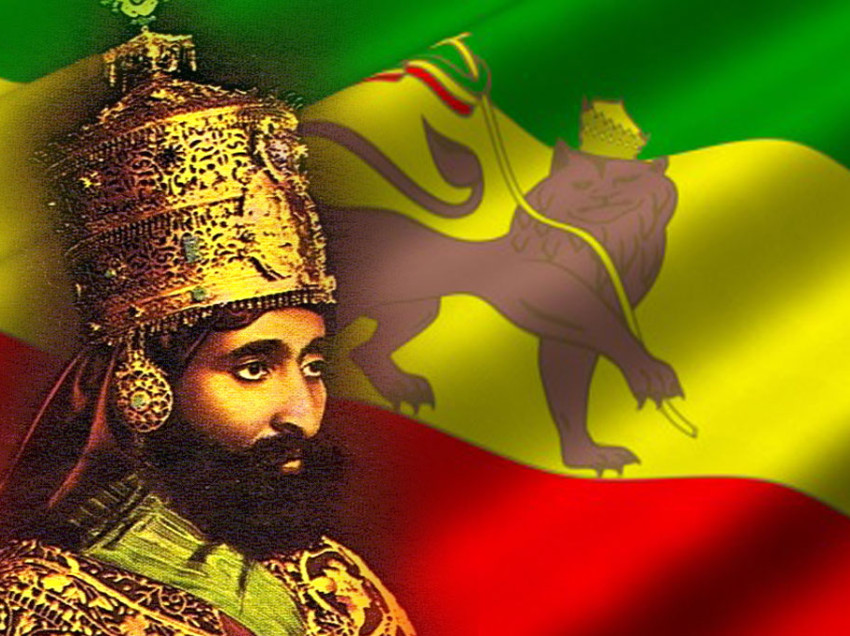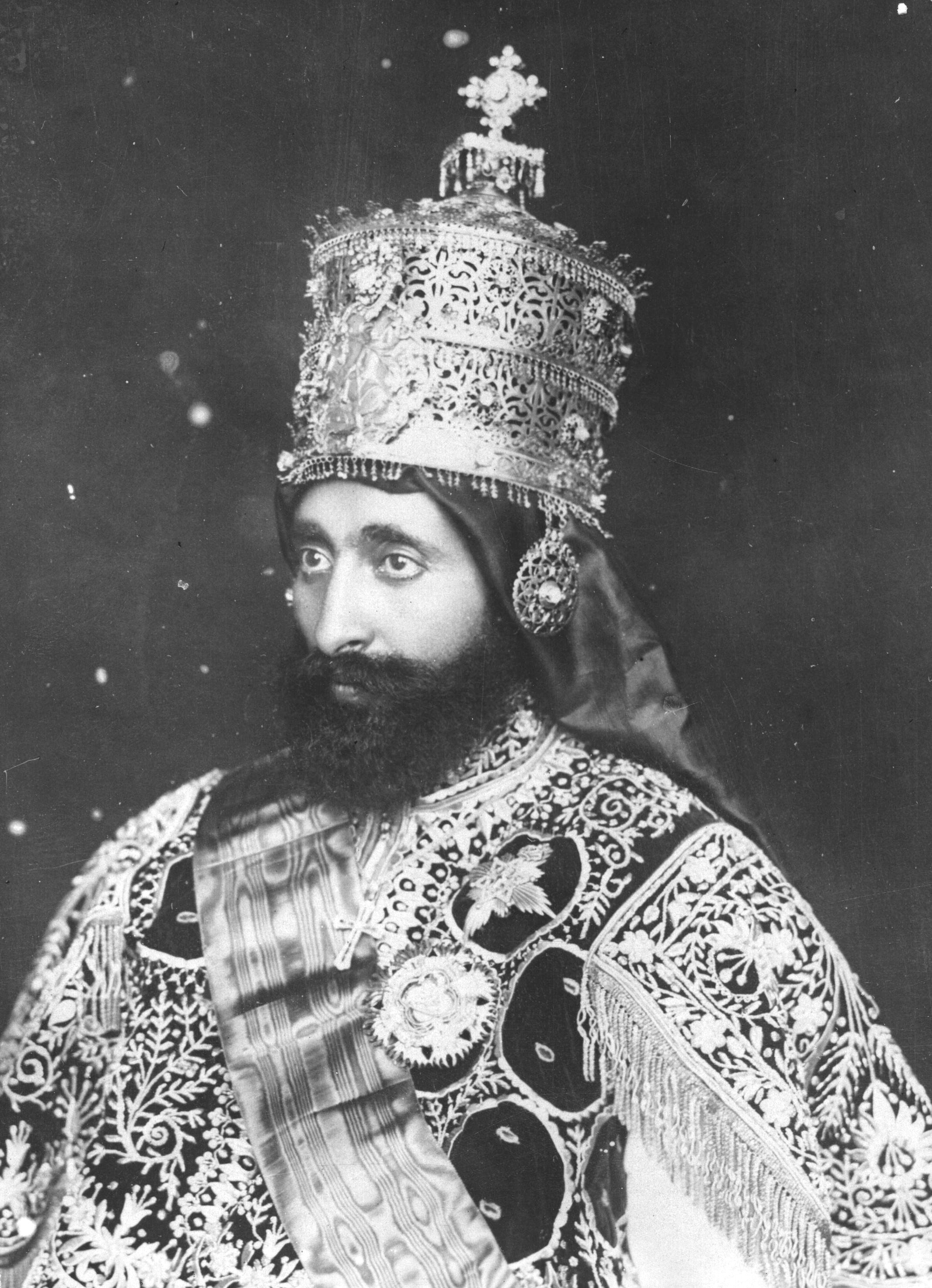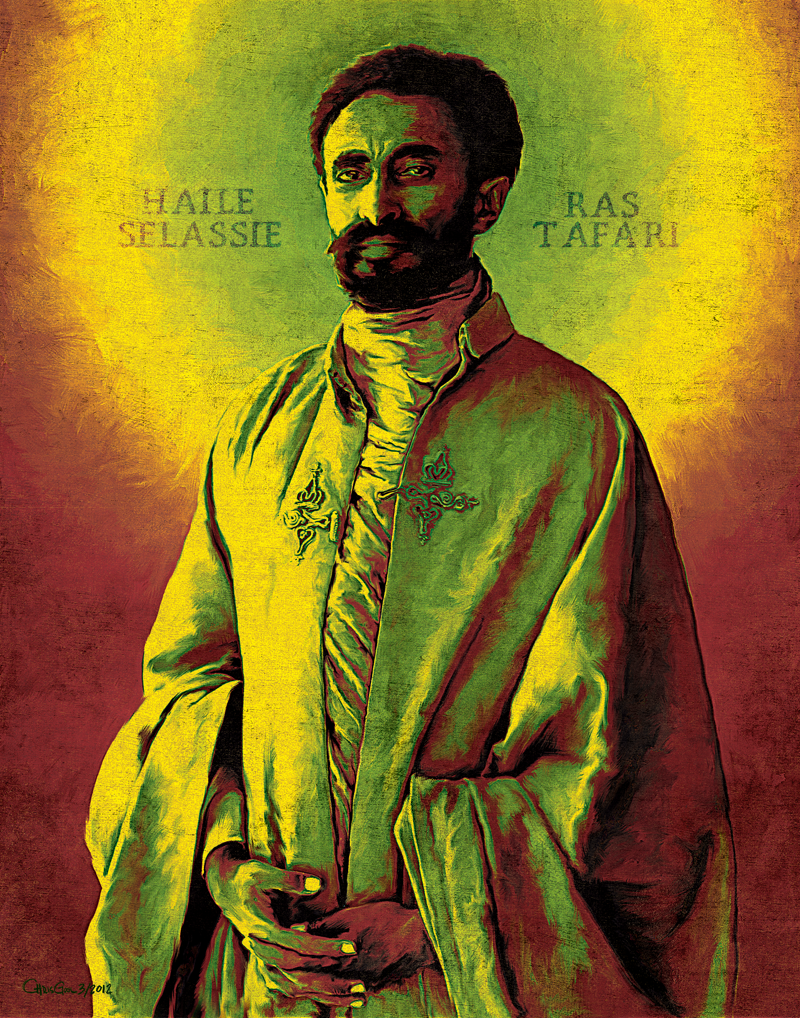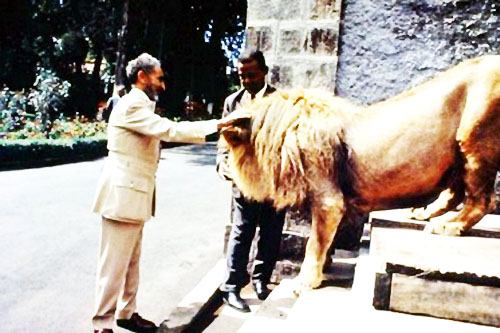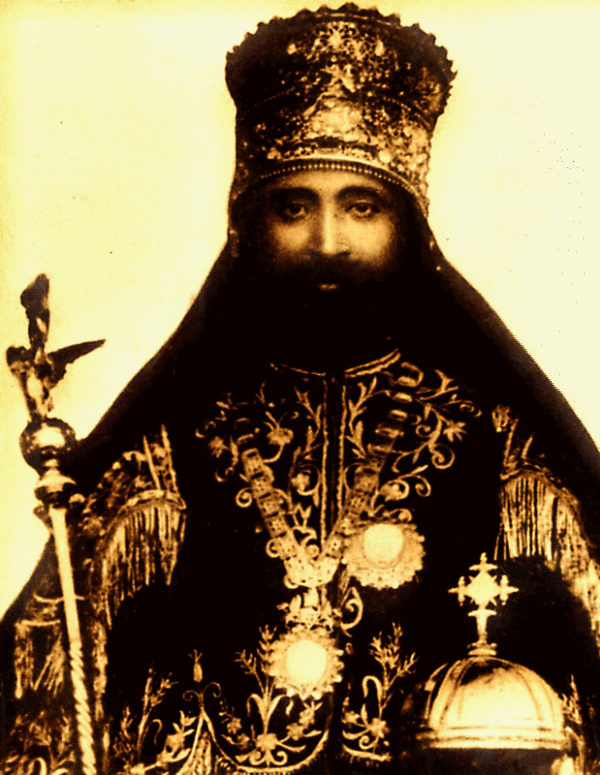<< Throughout history, it has been the inaction of those who could have acted; the indifference of those who should have known better; the silence of the voice of justice when it mattered most; that has made it possible for evil to triumph. >>
–
<< We must become bigger than we have been: more courageous, greater in spirit, larger in outlook. We must become members of a new race, overcoming petty prejudice, owing our ultimate allegiance not to nations but to our fellow men within the human community. >>
Haile Selassie (real name ras Tafari Makonnen, 1892-1975) was Negus Neghesti and last Emperor of Ethiopia from 1930 to 1936, and from 1941 to 1974.
He was the heir of the Solomonic Dynasty, which originated from King Solomon and the Queen of Sheba. When the Ethiopian Empire was invaded and conquered by fascist Italy in 1936, he chose voluntary exile, until 1941, when Britain won the Italian East Africa and handed back the throne to the Negus. It will again be dethroned in 1974, when Mengistu Haile Mariam overthrew the empire and transformed Ethiopia into a socialist State.
At the League of Nations in 1936, the Emperor condemned the use of chemical weapons by Italy against his people during the Second Italo–Ethiopian War. His internationalist views led to Ethiopia becoming a charter member of the United Nations, and his political thought and experience in promoting multilateralism and collective security have proved seminal and enduring. His suppression of rebellions among the landed aristocracy (the mesafint), which consistently opposed his reforms, as well as what some critics perceived to be Ethiopia’s failure to modernize rapidly enough, earned him criticism among some contemporaries and historians.
Among the Rastafari movement, whose followers are estimated at between two and four million, Haile Selassie is revered as the returned messiah of the Bible, God incarnate. Beginning in Jamaica in the 1930s, the Rastafari movement perceives Haile Selassie as a messianic figure who will lead a future golden age of eternal peace, righteousness, and prosperity. Haile Selassie was an Ethiopian Orthodox Christian throughout his life. He is a defining figure in both Ethiopian and African history.
Haile Selassie died (or better, disappeared) on 27 August 1975 at the age of 83, following a coup d’état.
According to the Ethiopian tradition Ras Tafari Makonnen, crowned Emperor with the new name of Haile Selassie I, is the 225th descendant of the Solomonic dynasty, through the line of David, belonging to the Tribe of Judah.
In the ancient Ethiopian sacred text Glory of Kings, the Queen of Sheba (ie Ethiopia) called Macheda met King Solomon (1 Kings 10; 2 Chr 9), and they had a son together, the first-born, crowned king with the title of Menelik I. From this sovereign, through 224 generations would descend Haile Selassie. According to the Ethiopian tradition, following the royal line of direct descent, the 225th heir to the throne is the last King of Kings.
Initially Ras Tafari is considered as the possible successor to his cousin Menelik, but the throne goes to the Muslim Lij Iasù V. Selassie, in 1916, participates in a coup, hatched to prevent a Muslim to rule over very Christian kingdom of Ethiopia, and it makes him depose, becoming regent during the reign of Empress Zauditù. The coup was well received by the population, since their former Muslim emperor had a reputation as a person prone to cruelty and to a life of sexual excesses, hardly suited with the tradition of the aristocratic Ethiopian elite.
During the regency he promotes the modernization of the country and in 1923 obtained Ethiopia’s entry into the League of Nations, the first African country to join. In 1924 he performs an official visit to Italy and the Vatican, as well as several other European countries. He is first crowned Negus Neghesti (King of Kings) in 1928 and, at the empress’ death, becomes emperor (November 2, 1930) under the name of Haile Selassie, meaning “Power of the Trinity”. In 1930 he issued the first Ethiopian constitution (which is inspired in many ways to the Japanese constitution of 1889), in 1931 creates a first Senate of notables and later founded the University of Addis Abeba. Throughout the period between 1916 and 1930 was used to modernize the country in a centralizing and westernising sense, though with great caution, trying to replace feudalism and the slavery system with a more modern and liberal form of government, as well as adapting the economic system to the industrialization. The public administration in 1930 was much more efficient, also chosen based on merit and not just according to the birth’s rights, and with officials and diplomats by reprobated capacity and culture. Moreover the international situation of the kingdom was greatly improved. Tense, however, was the relationship with the Fascist Italy, which could not see nicely to the modernization of Ethiopia, was trying to hamper and financing the conspiracies and the resistance of the great feudal aristocracy and, in 1930, even tried to foster the evasion of Iasù (noticeable is the Fascist sympathy for Muslim rulers). After 1930 the modernization program of the country – since the Ethiopian intelligence confirmed the presence in Italy of a strong war party and impressive works of preparation to the invasion – had to focus on rearmament and modernization of the army, that from that moment on became the main item of expenditure for the state. It was also founded a small aviation.
One of the problems that emerged in the ’20s was the shortage of revenue for the state, combined with the weakness of strong foreign exchange reserves, for this taxing was repeatedly raised at a high level that also created some unrest.
The abolition of slavery was often tempted, were abolished the trafficking and the sale of slaves, promulgated rules to promote the concept of “free womb” (the son of a slave was not a slave) and to make convenient the release of slaves. The number of slaves so slowly reduced from about 700,000 to almost 500,000 in 1932, in a gradual process that would lead to the complete elimination of this practice by 1940. As in all works of modernization of Selassie also in this occurred his usual prudence, in order to bring out his country from the “medieval” age without tears or traumas – as differently did in those years Ataturk – and focusing more on education and modernization of consciences.
The emperor was also famous for its peaceful and patient character, for his ability to handle the court conspiracies painlessly, for the love of culture, both traditional and Western, his passion for dogs, excellent propaganda skills, attention to the press and media, the taste for the ceremonial pomp at court.
On October 2, 1935 Mussolini announces war against Ethiopia; the next day Haile Selassie called together his soldiers with hard and touching words while on October 19 advises the military commander Ras Kassa Darghiè to use guerrilla tactics and focus on anti-aircraft artillery. Meanwhile, on November 18 Italy is hit by economic sanctions, approved by 50 states belonging to the League of Nations, with the sole vote against of Italy itself and the abstention of Austria, Hungary and Albania.
A few weeks later, Selassie gathers his imperial guard and moves northward, to meet the Italian army. The two forces clash in the valley of Mai Ceu. At dawn on 31 March the Abyssinians attacked the Alpines but are blocked and finally rejected. The battle ended with losses on both sides but a clear, serious Ethiopian defeat. Badoglio estimated losses at over 8,000 Ethiopian casualties, while the Italian losses were 68 officers, 332 national soldiers and 873 Eritrean askari.
The defense of Addis Ababa and the south of the country appeared then very critical, because the bulk of the Ethiopian army had been hit hard, especially by the Italian air force and artillery, with the use too of gas and chemical weapons against which Ethiopians could not oppose nothing but some hundreds of old gas masks, moreover not always working. It was then decided not to defend the capital and let escape the emperor by the country for fear of seeing the city completely destroyed by the aviation.
Just before the completion of the Italian conquest, Haile Selassie chose a volunteer exile from his country and went to Bath, in the UK, after being for a few days in Jerusalem (Israel). When, on May 12, the League of Nations granted him the opportunity to give a speech to the assembly, the vile fascist Italy withdrew its delegation. The Emperor of Ethiopia, in his speech deliberately hold in Amharic (despite he knew French) denounced the use by the Italian army of chemical weapons against the population of Ethiopia.
Ethiopia was never completely pacified by the Italian conquest, armed bands of partisans of the Emperor and groups related to local independist movements waged a guerrilla war continued, with temporary successes and failures. To the Ethiopian resistance followed a fierce repression and mass shootings, besides the use of poison gas. According to official data presented by the Ethiopian government in 1945, during the invasion and the “pacification” of the country had died 275,000 civilians and soldiers. The infamous aristocrats had chosen to support the shameful Italian colonialism and to assume collaborationist positions.
Selassie returned to his homeland on January 20th of 1941, contributing to the defeat of fascist Italy and the fall of the Italian Eastern Africa, with the cooperation of the Ethiopian resistance headed by the Arbegnuoc group. Especially the emperor was able to convince the British government to send him to Sudan and participate in the invasion of the south front of the colony, leading the Gideon Force, headed by the British Major Orde Wingate and formed by British troops, Sudanese and two battalions of the reconstituted Abyssinian Imperial Guard. The relationship between the emperor and Wingate was frank and cordial, more tense those with the British Government, which wanted to replace Italians in Eastern Africa management.
The Emperor’s appeals were able to facilitate some popular uprisings against the Italians, reassemble the rebel movement, compelled several aristocrats collaborators to reconsider their positions and to give up the support to the colonial government. Particularly significant was the decree of St. Michael, issued on January 20, 1941 simultaneously to the entrance in Ethiopia of the Emperor, in which was granted amnesty to all Ethiopians who had collaborated with the Italians, and which appealed to the people to act with chivalry and respect for Italian prisoners: “I Sallasié recommend you to accept in a convenient manner and to take custody of all the Italians who will surrender, with or without weapons. Do not blame them for the atrocities they have done to our people. Show them that you are soldiers who own a sense of honor and a human heart. I particularly recommend to respect the lives of children, women and the old. Do not loot the property of others even if they belong to the enemy. Do not burn the houses.”
The Gideon Force continued its offensive rapidly from the south-west, also because Italians focused most of their garrisons in the Shoa and against the Anglo-Indian troops in Eritrea and the Anglo-South African troops in Somalia. The retreat continued: Debra Marcos is abandoned on April 4, 1941: it was the first provincial capital to return to the emperor’s hands. Reinforced by the arrival of several guerrilla soldiers the 3,000 men of the original Gideon Force marched to the capital, while other Ethiopians regular departments defeated the Italian garrisons remained, and chased the general Maravetano who was forced to surrender with 10,000 men in the plain of Agibar, unable to join Amedeo di Savoia on the Amba Alagi.
Haile Selassie returned triumphantly to Addis Ababa on May 5, 1941, 5 years after the Italian occupation, officially retaking the title of Emperor. On this occasion too was shown the chivalrous attitude of the emperor towards Italian civilians (approximately 35,000) concentrated in the capital, were prevented reprisals and revenges, was issued a pardon decree, where among other things he said: “Because today is a day of happiness for all of us, since we beat the enemy, let us rejoice in the spirit of Christ. Therefore do not repay evil with evil. We’ll take the weapons from the enemy and we will let them go home by the same way which he is come.”
After the war Haile Selassie is still working to modernize the country, suppressing the power of the land aristocracy, reforming the army and promulgating the Second Constitution in 1955. The model was no longer that Japanese imperial of 1889 or the Prussian one, but the imperial power remained very high and most of the democratic openings initially planned (trade union freedoms, civil, multiparty etc.) were quashed even before the promulgation for the hostility of the nobility and the church, with which Selassie wanted to avoid breakage.
This cautious reformism, which could in fact move forward the country without fulfilling the aspirations of its intellectuals, began to create problems to the sovereign. After 1941 the government met the lacerating crisis with its intelligentsia, and various plans of revolution or conspiracies of the “left” or in any case pursued by the democratic opposition, progressive, socialist and/or communist, or other forces that were sometimes bluntly republican or demanded a British-style constitutional monarchy.
In the ’40s Britain tried, but failed, to put under “protection” Ethiopia, and Italy had to resign and give away even the Eritrea, which returned a kingdom united dynastically to Ethiopia, guaranteeing to the empire also access to the sea. The federation with Eritrea came after a UN vote in 1950 (Italy did the “NO” campaign), and finally was formalized with the retreat of the British in 1952. The empire thus reached its greatest territorial extent, not only but Selassie was able, with a skillful diplomatic game, to prevent the projects (Italian and British) to build to its disadvantage a great Somalia, Islamic and fundamentalist. Ethiopia was also a founding member of the United Nations, and managed to conquer in this field considerable clout and visibility.
Moreover tried not to bind to the British Empire, maintaining an independent government. Although firmly placed in the Western camp, he was far from becoming an American puppet, maintained formal and fruitful diplomatic contacts with the Soviet Union, informal with China and took part to the movement of Non-Aligned States and the Afro-Asian conference.
Haile Selassie is of particular international notoriety when Ethiopia became guide of the Organisation of African Unity (OAU, now the African Union), placing himself firmly at the head of the decolonization movement.
More complicated were the relations with Italy. Diplomatic relations were resumed in 1951, after that for 6 years Italy had hoped to still receive the Colonial Office on Eritrea. The relations were complicated by the lack of sympathy that the “DC” (Christian Democrats) had for him personally. Selassie on the contrary wanted to use Italy to balance the weight of the British in the East African issues, and maintain as much as possible the presence of the former Italian settlers in the Empire, because they were placed very well in some key economic sectors (transport, small food industry, export-import, engineering, etc.).
The Italian Government, in this instance the Ministry of Colonies (active until 1961), was particularly slow to grasp the post-colonial dimension of Ethiopian history, in addition not to wanting recognize the reality of the defeat. Of the US$ 25 million (instead of 185 million pound, an amount that Selassie had kept artificially low so not to humiliate Italy) of the war damage and colonial robberies suffered by Ethiopia, Italy only paid 16 million. It was also very difficult, and a source of great irritation for Emperor, the restitution of the gold reserves of the Bank of Ethiopia, the royal treasury (including crowns and jewels of the crown), the artworks looted (like the statue of the Lion of Judah and the Obelisk of Axum). Some of these refunds took place well after the death of Selassie.
In the last years of his life, Haile Selassie became highly suspicious of his closest collaborators because of the betrayals that follow one another against him. In 1974 he broke out a tough army revolt led by a military junta, which forces Haile Selassie to operate a number of concessions in favor of the armed forces. Haile Selassie simply disappear on August 27, 1975 in mysterious circumstances.
“Conquering Lion of the Tribe of Judah, Lord of Lords, King of Kings, Light of the World, Elected of the Lord”
The last Negus is considered by the members of Rastafarianism the new Messiah and the second incarnation of Jesus. Among the followers of this religion, Haile Selassie is regarded Jesus Christ returned in glory to reign with a new name, the embodiment of Jah, the supreme God, came to earth to rid nations from evil Nazi-Fascism. The name of the Rastafari movement comes from the first name of Emperor Ras Tafari, which in Amharic means “Chief to fear.”
Considered the Messiah by the Rastafari religion, Selassie was, however, always devoted to the Ethiopian Orthodox Church, a very ancient Christian church in which several Ethiopians and Rastafarians identify themselves since it considered the King of Kings Haile Selassie as the Lion of Judah of Revelation.
Source: Wikipedia (Italian)
